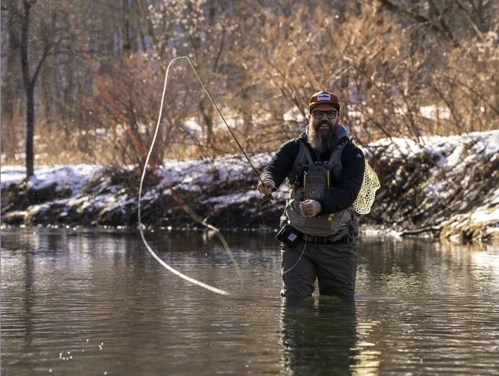Brilliant fall colors are not only found in trees, but also in streams and the Manchester Fish Hatchery. These underwater splashes of color are signs that trout spawning season is in full swing.
Thanks to an increase in self-sustaining, naturally reproducing brown trout populations, there was no need to collect brown trout eggs this fall. Today, all brown trout caught by anglers have spent their entire lives in the stream. Past stockings of French Creek-strain brown trout have helped to establish wild fisheries throughout Northeast Iowa.
“Anglers like these wild, stream-raised fish. They are harder to catch than our hatchery-raised stocked fish,” said Dan Rosauer, Iowa DNR trout hatchery manager. “Nearly all public trout streams have lots of brown trout in them.”
Years of work to protect and enhance the South Pine Creek watershed in Winneshiek County has allowed Iowa’s only native trout, the brook trout, to thrive and continue to naturally reproduce in that stream. Eggs are typically taken streamside in early November from wild South Pine Creek brook trout, fertilized and taken back to the Manchester Fish Hatchery and grown to 2-inch fingerlings by the following June. Those fingerlings are then stocked throughout Northeast Iowa to develop new brook trout populations in other streams.
“The recent drought put additional pressure on our trout streams over the past couple years, so we gave the South Pine Creek brook trout a bit of a break this fall,” said Rosauer. Milt was collected from a portion of South Pine Creek as well as another stream with a restored population of brook trout.
“The milt collected from wild male brook trout will be used to fertilize about 100,000 eggs from South Pine-strain female brook trout currently held at the Manchester Fish Hatchery,” explains Rosauer.
The rainbow trout spawn, the backbone of Iowa’s trout program, takes up much of December and January. Roughly 750,000 eggs will be collected this season.
Crews check for ripe female broodstock once a week. After a quick sedative bath to calm them, each big trout is held over a plastic bowl, as one of the workers rolls a hand down her belly to force out a stream of bright orange eggs—up to 6,000 per fish. The milk-white milt from two males is mixed in. Water is added to activate the eggs and milt, allowing fertilization to occur. The ingredients are gently stirred to avoid bruising the eggs.
The fertilized eggs are poured into an incubator tray and slid into their place below a stream of 50 to 52 degree water until they hatch. Tiny sac-fry hatch about 30 days after fertilization. Dark clouds of tiny fish grow in raceways at the hatchery. The fish are hand-fed for the first month, then “trained” to eat from automatic feeders.
As the trout develop and grow, they are monitored and transferred to larger tanks, then raceways. The fingerlings will be kept at Manchester or transferred to Iowa’s two other stations, near Elkader and Decorah, to be raised for future stocking. In 13 to 15 months, they will be a half-pound and ready to be stocked. Nearly 50 put-and-take streams throughout nine northeast Iowa counties are stocked from April through October and almost 20 community trout fishing locations are stocked through the cold weather months.
“We stock about 370,000 catchable rainbow trout from the hatcheries,” said Rosauer. “We also stock about 60,000 brook and rainbow trout fingerlings each year to grow in the streams.”
There’s natural spawning, mostly brown trout and some brook trout, in more than 100 northeast Iowa streams thanks to improved habitat and trout genetics, and an extended period of above average annual rainfall prior to the drought these past two years. Many trout caught, though, are spawned under the eyes of hatchery workers at Manchester. These coldwater fish are great fighters and beautiful in their spawning colors this time of year.
Find more information about Iowa trout streams and tips for trout fishing on the DNR website at www.iowadnr.gov/trout.
